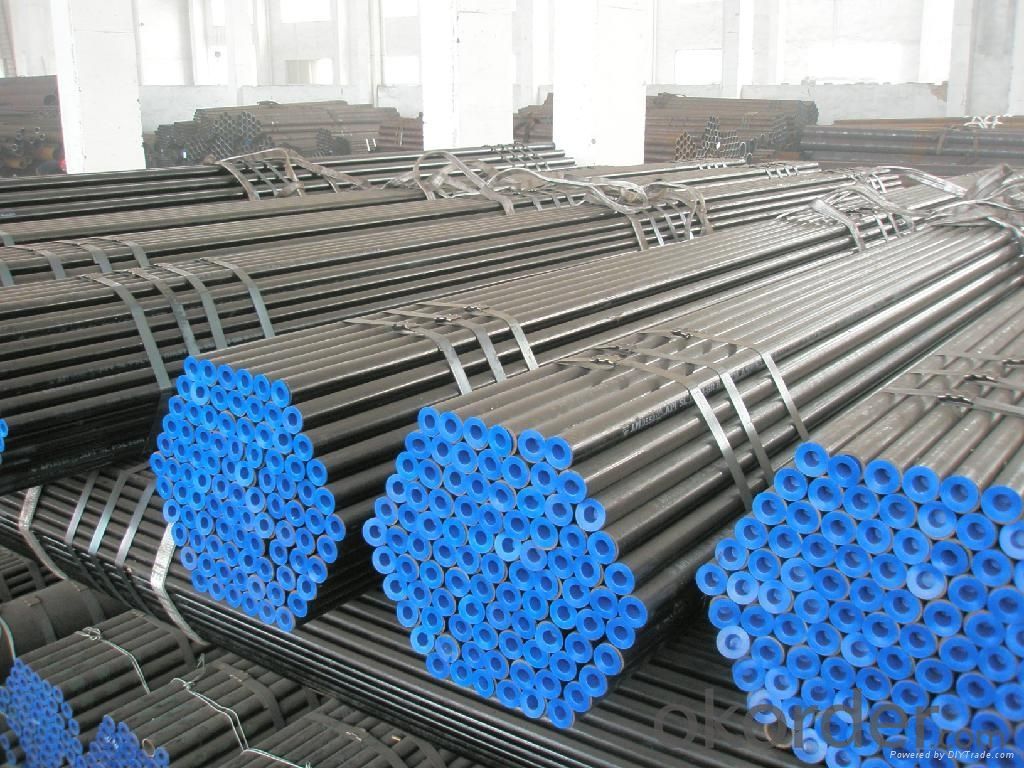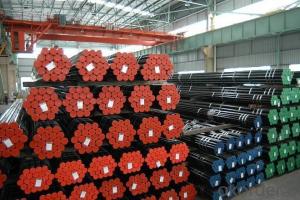Seamless Steel Pipe API 5L All Sizes High Quality
- Loading Port:
- China main port
- Payment Terms:
- TT OR LC
- Min Order Qty:
- 50 m.t.
- Supply Capability:
- 10000 m.t./month
OKorder Service Pledge
OKorder Financial Service
You Might Also Like
Item specifice
Seamless Steel Pipe API 5L All Sizes Best Quality
Structure:
Seamless pipe is formed by drawing a solid billet over a piercing rod to create the hollow shell. As the manufacturing process does not include any welding, seamless pipes are perceived to be stronger and more reliable. The usage is to convey water, gas, oil and so on.
Main Features:
• High manufacturing accuracy
• High strength
• Small inertia resistance
• Strong heat dissipation ability
• Good visual effect
• Reasonable price
Specification:
Standard | GB, DIN, ASTM ASTM A106-2006, ASTM A53-2007 |
Grade | 10#-45#, 16Mn 10#, 20#, 45#, 16Mn |
Thickness | 8 - 33 mm |
Section Shape | Round |
Outer Diameter | 133 - 219 mm |
Place of Origin | Shandong, China (Mainland) |
Secondary Or Not | Non-secondary |
Application | Hydraulic Pipe |
Technique | Cold Drawn |
Certification | API |
Surface Treatment | factory state or painted black |
Special Pipe | API Pipe |
Alloy Or Not | Non-alloy |
Length | 5-12M |
Outer Diameter | 21.3-610mm |
Grade | 20#, 45#, Q345, API J55, API K55, API L80, API N80, API P110, A53B |
Standard | ASME, ASTM |
1) Material:20#(ASTM A 106/A53 GRB.API5LGRB,GB),45#,16Mn,10#.
2) Specification range:OD:21.3-610mm,WT:6-70mm,length:6-12m or according to the requirement of clients.
3) Excutive standards:GB,ASME API5L.ASTM A 106/A53,Despite of the above standards,we can also supply seamless steel pipe with standard of DIN,JIS,and so on,and also develop new products according to the requirements of our clients!
4) Surface:black lacquered,varnish coating or galvanized.
5) Ends:Beveled or square cut,plastic capped,painted.
6) Packing:bundles wrapped with strong steel strip,seaworthy packing.
Our advantages:
Our products are manufactured strictly according to national and internaional standard, and we take a test
on every pipe before delivered out. If you want see our quality certifications and all kinds of testing report, please just ask us for it.
Guaranteed: If products’ quality don’t accord to discription as we give or the promise before you place order, we promise 100% refund.

- Q:What are the different types of steel pipe tees?
- There are three main types of steel pipe tees: equal tee, reducing tee, and barred tee.
- Q:Theoretical weight of 25*25*1.5 square steel tubes
- The theoretical weight of 25*25*1.5 square steel tubes is 1.075kg/m.
- Q:What's the gate number of the precision steel pipe?
- Precision steel pipe refers to the high precision steel pipe, the wall thickness and internal and external diameter can be controlled within 10 wire tolerance range
- Q:What is the load-bearing capacity of steel pipes?
- The load-bearing capacity of steel pipes depends on various factors such as the diameter, wall thickness, and grade of the steel used. Generally, steel pipes have high load-bearing capacity due to their inherent strength and durability. The load-bearing capacity can be determined through engineering calculations and testing methods. These calculations consider factors like the applied load, pipe dimensions, and the material properties of the steel. It is important to consult engineering standards and guidelines, as well as a structural engineer, to accurately determine the load-bearing capacity of specific steel pipes for a given application.
- Q:How are steel pipes used in data centers?
- Steel pipes are used in data centers for the installation of cooling systems, electrical wiring, and network cabling, providing a robust and reliable infrastructure to support the data center's operations.
- Q:What are the factors affecting the cost of steel pipes?
- The factors affecting the cost of steel pipes include raw material prices, production and manufacturing costs, transportation and logistics expenses, market demand and supply dynamics, import and export tariffs, government regulations, and the overall economic conditions. Additionally, factors such as the grade and quality of steel used, diameter and thickness of the pipes, and any additional features or coatings can also influence the cost.
- Q:What are the different methods of threading steel pipes?
- There are several methods of threading steel pipes, including manual threading, machine threading, and dielectric threading. Manual threading involves using a manual pipe threader or a handheld die to create the threads on the pipe. Machine threading, on the other hand, utilizes power-driven machines that can thread multiple pipes simultaneously, increasing efficiency and accuracy. Dielectric threading is a specialized method that uses a high-frequency electrical current to generate threads on the pipe, which is commonly used for stainless steel pipes.
- Q:What are steel pipes?
- Steel pipes are cylindrical tubes made from steel that are used for various purposes, such as transporting fluids and gases, structural applications, and construction projects. They are known for their durability, strength, and resistance to corrosion, making them a popular choice in industries such as oil and gas, plumbing, and infrastructure development.
- Q:How are steel pipes used in the construction of stormwater drainage systems?
- Steel pipes are commonly used in the construction of stormwater drainage systems due to their durability and strength. They serve as underground conduits to efficiently transport stormwater away from built-up areas, preventing flooding and water damage. Steel pipes offer high resistance to external pressure and are capable of withstanding heavy loads, making them suitable for underground installations. Additionally, their corrosion-resistant properties ensure long-term effectiveness and minimize maintenance requirements. Overall, steel pipes are essential components in stormwater drainage systems, providing reliable and efficient water management solutions.
- Q:What are the different methods of pipe inspection for steel pipes?
- Steel pipes can be inspected using various methods. Here are some commonly employed techniques: 1. Visual Inspection: Trained inspectors visually examine both the exterior and interior of the pipe to detect any visible defects or abnormalities. This preliminary method is often used before more advanced techniques are applied. 2. Magnetic Particle Inspection (MPI): By applying a magnetic field to the steel pipe and iron particles to its surface, inspectors can identify surface cracks or defects. Leakage of magnetic flux caused by these abnormalities can be detected with this method, which is particularly effective for ferromagnetic materials. 3. Ultrasonic Testing (UT): UT is a non-destructive testing method that utilizes high-frequency sound waves to identify internal defects or anomalies in steel pipes. A transducer sends ultrasonic waves into the pipe, and reflections or echoes of the sound waves are analyzed to determine the presence of defects, such as corrosion, cracks, or variations in wall thickness. 4. Radiographic Testing (RT): This method involves using X-rays or gamma rays to create an image of the internal structure of the steel pipe. The resulting image reveals any defects, such as cracks, corrosion, or weld discontinuities. RT is commonly used for inspecting welded joints. 5. Eddy Current Testing (ECT): ECT is a non-destructive testing technique that utilizes electromagnetic induction to detect surface and near-surface defects in steel pipes. By passing a coil carrying an alternating current over the pipe's surface, any changes in electrical conductivity or magnetic field caused by defects are detected and analyzed. 6. Acoustic Emission Testing (AET): AET involves detecting and analyzing high-frequency acoustic signals emitted by materials undergoing deformation or damage. In the case of steel pipes, AET can monitor and identify defects like cracks, leaks, or corrosion by analyzing the acoustic signals emitted during service or under stress. These methods are just a few examples of commonly used techniques for inspecting steel pipes. The choice of method depends on factors such as the type of defect being sought, accessibility of the pipe, desired sensitivity level, and cost and time constraints. Using a combination of inspection techniques is often recommended to ensure a thorough assessment of steel pipes.
1. Manufacturer Overview |
|
|---|---|
| Location | |
| Year Established | |
| Annual Output Value | |
| Main Markets | |
| Company Certifications | |
2. Manufacturer Certificates |
|
|---|---|
| a) Certification Name | |
| Range | |
| Reference | |
| Validity Period | |
3. Manufacturer Capability |
|
|---|---|
| a)Trade Capacity | |
| Nearest Port | |
| Export Percentage | |
| No.of Employees in Trade Department | |
| Language Spoken: | |
| b)Factory Information | |
| Factory Size: | |
| No. of Production Lines | |
| Contract Manufacturing | |
| Product Price Range | |
Send your message to us
Seamless Steel Pipe API 5L All Sizes High Quality
- Loading Port:
- China main port
- Payment Terms:
- TT OR LC
- Min Order Qty:
- 50 m.t.
- Supply Capability:
- 10000 m.t./month
OKorder Service Pledge
OKorder Financial Service
Similar products
New products
Hot products
Hot Searches
Related keywords






























